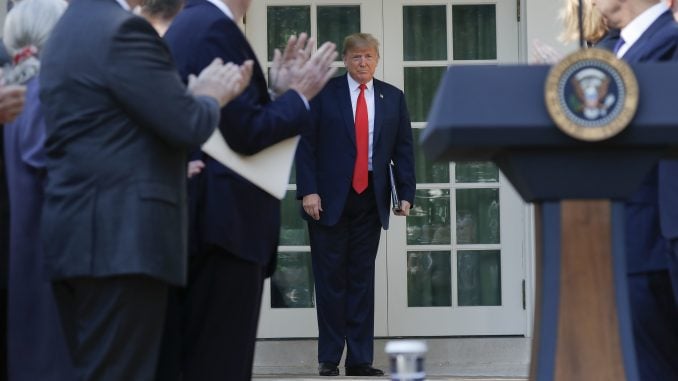
WASHINGTON, D.C. — Just ahead of a midnight deadline on Sunday, the U.S., Canada and Mexico reached a trade deal to replace the North American Free Trade Agreement.
President Donald Trump hailed his revamped North American trade deal and vowed to sign it by late November. But a lengthy path remains to congressional approval on an issue that has served for two decades as a political football for U.S. industrial policy and the loss of manufacturing jobs.
Embracing the U.S.-Mexico-Canada Agreement during a Rose Garden ceremony, Trump branded the trade deal the “USMCA,” a moniker he said would replace the 24-year-old North American Free Trade Agreement, or NAFTA.
But Trump noted that the deal would need to be ratified by Congress, a step that could be affected by the outcome of the fall congressional elections as Democrats seek to regain majorities in the House and Senate. When told that he seemed confident of congressional approval after his announcement, he said he was “not at all confident” — but not because of the deal’s merits or defects.
“Anything you submit to Congress is trouble no matter what,” Trump said, predicting that Democrats would say, “Trump likes it so we’re not going to approve it.”
Canadian Prime Minister Justin Trudeau had opposed the deal until very recently, but he said Monday that his country was in a more stable place now that it had completed the negotiations. He said the deal needed to be fair since one trading partner is 10 times larger. He said Canada did not simply accept “any deal.”
“We got the right deal. We got a win-win-win for all three countries,” Trudeau said.
The agreement gives U.S. farmers greater access to the Canadian dairy market. But it keeps the former North American Free Trade Agreement dispute-resolution process that the U.S. wanted to jettison. It offers Canada protection if Trump goes ahead with plans to impose tariffs on cars, trucks and auto parts imported into the United States.
The National Association of State Departments of Agriculture (NASDA) came out in support of the deal on Monday evening.
“We are especially appreciative for the administration’s efforts to address market access challenges with Canada for dairy, wheat and wine. NASDA has been pressing since 2014 for solutions to these challenges,” said NASDA President and New Mexico Secretary of Agriculture Jeff Witte.
North Carolina Congresswoman Virginia Foxx (N.C.-5) voiced her support for the deal and the president.
“Congratulations to President Trump and his administration on this victory for America’s interests and groundbreaking achievement in securing digital trade, intellectual property and new agricultural markets. I look forward to Congress’s exertion of its authority over this agreement in the coming months,” she said in a statement.
NAFTA reduced most trade barriers in North America, leading to a surge in trade between the three countries. But Trump and other critics said it encouraged manufacturers to move south of the border to take advantage of cheaper Mexican wages, costing American jobs.
Trump had threatened to go ahead with a revamped NAFTA, with or without Canada. It was unclear, however, whether he had authority from Congress to pursue a revamped NAFTA with only Mexico.
Flanked by Cabinet members on a sunny morning at the White House, Trump said the pact was the “most important deal we’ve ever made by far,” covering $1.2 trillion in trade.
For Trump, the agreement offered vindication for his hardline trade policies that have roiled relations with China, the European Union and America’s North American neighbors while causing concerns among Midwest farmers and manufacturers worried about retaliation. Trump’s advisers view the trade pact as a political winner in battleground states critical to the president’s 2016 victory and home to tens of thousands of auto workers and manufacturers who could benefit from the changes.
Trump said he would sign the final agreement in late November, in about 60 days, and the pact is expected to be signed by Trudeau and outgoing Mexican President Enrique Pena Nieto before he leaves office Dec. 1. Trump said he spoke to Trudeau by phone and told reporters that their recent tensions didn’t affect the deal-making. “He’s a professional. I’m a professional,” Trump said, calling it a “fair deal.”
Canada, the United States’ No. 2 trading partner, is by far the No. 1 destination for U.S. exports, and the U.S. market accounts for 75 percent of what Canada sells abroad.
But the president said his administration had not yet agreed to lift tariffs on steel and aluminum imports from Canada, a contentious issue between the two neighbors.
Trump has used U.S. tariffs on billions of dollars’ worth of imported goods from China and other nations as a negotiating tactic and said the North American deal offered evidence that his approach was working. “Without tariffs, we wouldn’t be standing here,” he said.
The new pact will require regional content of 75 percent for automobiles, and also that 40 to 45 percent of vehicles be produced in plants paying at least $16 per hour. Pena Nieto said via Twitter on Monday that the deal negotiated over the last 13 months “achieves what we proposed at the beginning: a win-win-win agreement.”
Ratifying the deal is likely to stretch into 2019 because once Trump and the leaders from Canada and Mexico sign the agreement, the administration and congressional leaders will need to write legislation to implement the deal and win passage in Congress.



